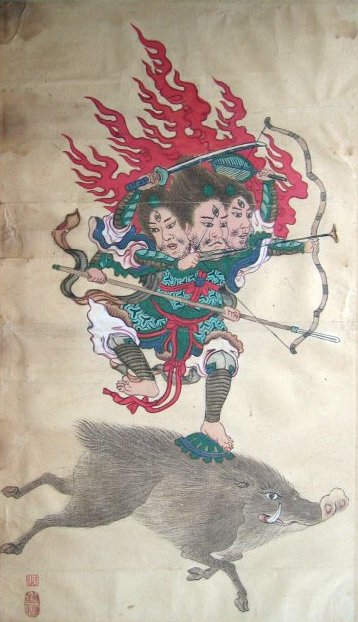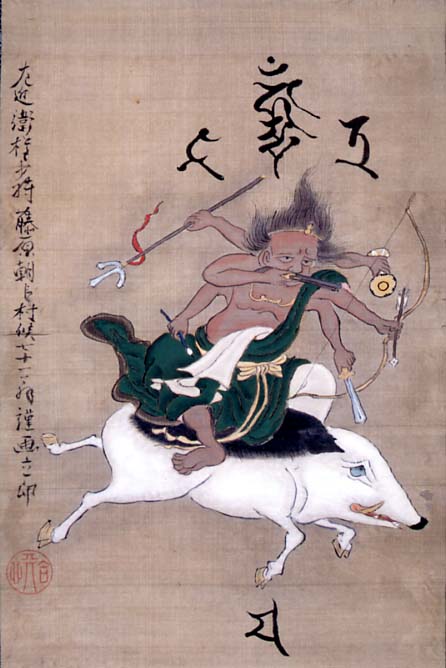|
|
 |
|
 |
|
JAPANESE VOTIVE TABLETS OF THE WILD BOAR (Japanese = Inoshishi 亥)
|
|
Votive tablets (known as EMA 絵馬, literally "HORSE PICTURES) are a longstanding tradition in Japan. They can be purchased at most shrines and temples for around $10 or less. You write your name and petition (prayer) on the back, and then hang the tablet inside the compound in the hope the deity will answer your prayer. Says JAANUS: "Ema are illustrated wooden plaques given as votive offerings to shrines and temples. It is believed that the custom of donating ema has its roots in the ancient practice of presenting a sacred white horse to a shrine for use in rituals and as an auspicious symbolic messenger of the gods. Later, small wooden statues of these sacred horses were presented as substitutes. These statues were then simplified to images of a horse carved in relief, usually on a wooden plaque. By the late Edo period (18th C.), paintings on ema came to depict not only the sacred horse but also a great variety of other subjects" -- including the 12 animals of the Asian Zodiac (which includes the wild boar). The sale of votive tablets and amulets is without doubt a key strategy of temples / shrines to attract popular attention & raise money.
|
|

Kumano Hayatama Shrine 熊野速玉大社
Shingu, Wakayama. Giant Votive Boar Tablet.
|

Niukanshōfu Shrine 丹生官省符神社
Kudoyama, Ito District, Wakayama. Giant Votive Boar Tablet.
|

Sosha Shrine 総社神社
Kawashirisoshamachi, Akita. Giant Votive Boar Tablet.
|
|

Female Attendants, Kumano Nachi Shrine 熊野那智大社
Higashimuro District, Wakayama
|

Small Votive Tablet
Available Online at Rakuten
|

10 Yen Bank Note (Back Side) from 1899 (Meiji 32)
Front shows statesman Wake no Kiyomaro & Go-ō Shrine
|
|
|
|
 |
|
REAL LIFE INOSHISHI (WILD BOARS 亥)
|
|

Wild boars can weigh up to 200 kg. They are common in most of Asia, especially in the countryside. They are normally secretive & wary of human contact, & become aggressive if provoked or threatened. But today, they are found more & more often in urban areas, where they search for food. See story here.
|
|
|
|
 |
|
WILD BOAR (PIG) IN JAPANESE & ENGLISH LANGUAGE
|
|
Pig, hog, sow, and boar essentially describe the same animal.
There are of course some distinctions. A boar is an uncastrated
male pig, either domesticated or wild. In Japan, phrases using the
term "wild boar" include reckless, foolhardy, daredevil, impulsive, impetuous, freewheeling, audacious, obstinate, and bold.
JAPANESE PROVERB 猫に小判 ・ 豚に真珠
Neko ni Koban, Buta ni Shinju
ENGLISH TRANSLATION
Casting Coins to a Cat, Casting Pearls Before Swine
MEANING
To offer valuable things to those who cannot appreciate them
Some of my favorite English phrases are:
High on the Hog, Hog Tied, Hog Wild, In a Pig's Eye
|
  猫に小判 ・ 豚に真珠 猫に小判 ・ 豚に真珠
|
|
|
|
 |
|
WILD BOAR (J = INOSHISHI) IN JAPANESE ART & RELIGIOUS LORE
|
|
In Japan, the wild boar is the mount of Marishiten 摩利支天. Marishiten is the god / goddess of prosperity, the warrior class, and entertainers in Japan. S/he is often depicted as a warrior with three heads and multiple arms, holding weapons, standing or sitting atop a sow or boar, or driving a chariot drawn by seven pigs. In Japan, this deity is also sometimes depicted as a beautiful female goddess of fortune standing or sitting on a lotus. In her female form, she is the consort of Dainichi Nyorai (Skt. = Vairocana), the Great Solar Buddha. In this role, she is the Goddess of Dawn, a personification of light, one identified with the blinding rays and fire of the rising sun, and thus with the power of invisibility and mirage. Marishiten's powers of illusion were probably the main reason she was adopted as the tutelary deity of street magicians and entertainers. Her mount, the boar, "represents audacious advance without fear, a desirable quality for a warrior."
|
|

Marishiten Painting, 1893
by Ono Kansai 小野閑哉
|

Marishiten Painting, Muromachi Era
Hong Kong Art & Collectibles Club
|

Marishiten Painting, 1793
Miura Family Collection
|
|

Marishiten Stone Carving, Edo Era
Daiunji Temple 大雲寺, Chikuma, Nagano
|

Marishiten Stone Carving, Edo Era
Yasumiya Shrine 安宮神社, Sakai, Nagano
|

Marishiten Stone Carving, Edo Era
Gosho Shrine 五所神社, Kamakura, Kanagawa
|
|
Above Three Photos of Stone Carvings Courtesy of: http://shinshizo.com/2018/07/神使になった-いのしし・猪/
|
|
|
|
 |
|
WILD BOAR & TENGU GOBLINS. In Japanese paintings and woodblock prints, the boar often appears as the steed of the Tengu 天狗 or of their king, Sōjōbō 僧正坊. Tengu are mountain and forest goblins with both Shinto and Buddhist attributes. Their supernatural powers include shape-shifting into human or animal forms, the ability to speak to humans without moving their mouth, the magic of moving instantly from place to place without using their wings, and the sorcery to appear uninvited in the dreams of the living.The patron of martial arts, the bird-like Tengu is a skilled warrior and mischief maker, especially prone to playing tricks on arrogant and vainglorious Buddhist priests, and to punishing those who willfully misuse knowledge and authority to gain fame or position. In bygone days, they also inflicted their punishments on vain and arrogant samurai warriors. They dislike braggarts, and those who corrupt the Dharma (Buddhist Law). One possible interpretation of the painting shown here (right column) relates to the following Zen story: "One day a hunter was in the mountains when he happened to see a snake killing a bird. Suddenly a boar appeared and began to devour the snake. The hunter thought he should kill the boar, but changed his mind because he did not want to be a link in such a chain, and cause his own death by the next predator to come along. On his way home he heard a voice call to him from the top of a tree. It was the voice of a Tengu. It told him how lucky he was, for had he killed the boar, the Tengu would have killed him. The man subsequently moved into a cave and never killed another animal." Source: A Field Guide to Demons, Fairies, Fallen Angels, and Other Subversive Spirits (by Carol Mack, Dinah Mack).
|

Crow Tengu Riding Boar (Karasu Tengu 烏天狗騎猪)
Painting, Edo Era, by Kaihō Yūtoku, Sairin-ji Temple 西林寺, Kyoto.
Photo: Faith & Syncretism: Saichō & Treasures of Tendai.
Kyoto National Museum catalog, 2005.
|
|
|
|
 |
|
WILD BOAR AND JAPAN'S "INOKO" WILD BOAR FESTIVAL
|
|
The rites of INOKO 亥の子 "young wild boar" came to Japan in the Heian Era (794-1185) from China, and thereafter developed into a "rock-pounding" harvest festival centered around the first day of the wild-boar month (the 10th month in the lunar calendar). This month is also called Inotsuki 亥の月 (month of the boar). Rituals during this time are most common in Western Japan.
In Japan, the young wild boar (Inoko 亥の子) is considered the messenger of the God of the Mountain (Yamanokami 山の神). Japan also linked its local harvest god -- Tanokami 田の神 (god of the rice fields) -- to the young wild boar. Tanokami is also called Inokami 亥の神 (God of the Boar). Rice cakes are prepared and eaten to celebrate the harvest, and these rice cakes are known as Inoko Mochi 亥の子餅 (rice cakes for the wild boar). During the annual wild-boar harvest festival, villagers and children pound the earth with a special stone suspended on long strings (see below photos), and the children sing the Inoko Song (Inoko Uta 亥の子唄):
Today we celebrate, we bury the demons in the ground,
We bury the snakes in the ground,
We bury demon children with horns in the ground.
On the evening of the Inoko wild-boar day, young men visit village homes that are celebrating newborn boys (in that year). If the family does not give them some money, they shout:
亥の子の晩に祝わん者は鬼産め蛇産め (Translation: Families who do not celebrate the Inoko evening will have a demon child, they will have a snake child !
There are many other traditions for the annual wild-boar harvest festival. For more, please see: Gabi Greve and also Interpreting Japanese Society: Anthropological Approaches, edited by Joy Hendry, 2003.
|

Poster Announcing the Inoko (Wild Boar) Festival
|
|

|

Source: https://ameblo.jp/nishijinjya-418/entry-12324656780.html
|
|
|
|
 |
|
|
|
 |
|
 |
|
|
Modern and Common Japanese New Year Calligraphy
|
|

|

|

|

|

|

|

|

|
|
Long Life (Jp. = Chōju)
|
Welcome Spring, Welcome Rebirth, Welcome the New Year (Jp. = Geishun)
|
Longevity (Jp. = Kotobuki)
|
|
|
 |
|
 |
|
|
HOLIDAY CARDS FROM PRIOR YEARS
|
|
2011 Rabbit
|
2012 Dragon
|
2013 Snake
|
2014 Horse
|
2015 Sheep
|
2016 Monkey
|
2017 Rooster
|
2018 Dog
|
|
user name = NY2011
password = guest
|
user name = NY2012
password = guest
|
user name = NY2013
password = guest
|
user name = NY2014
password = guest
|
user name = NY2015
password = guest
|
user name = NY2016
password = guest
|
user name = NY2017
password = guest
|
|
|
Copyright December 25, 2018, OnmarkProductions.com (Mark Schumacher)
|
|
|
|